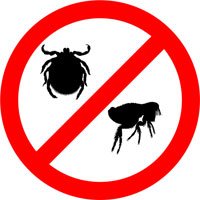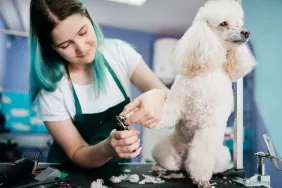While fleas may seem too tiny to cause much more than an inconvenience, an infestation of fleas on your dog can become a serious medical problem indeed. Your dog can run the gamut of reactions to fleas, from a mild skin irritation to a severe allergic response.
And because fleas feed on blood, a severe infestation can cause anemia or even death in some of the most serious cases. Unless you live in an extremely dry climate or at a high elevation, fleas will be a source of concern for you and your dog.
Although they are small in size, they are a hardy species, and some can live as long as six months to a year. During that time, a pair of fleas can create millions of offspring. Fleas have been around almost since the beginning of time, and have been shown to perform amazing feats for their diminutive size–some fleas are able to leap as high as three feet of the ground. That is the equivalent of a human jumping over the Washington Monument!
Because fleas are so small, you will often see evidence of the flea infestation before you will see the creatures themselves. Fleas will leave their mark on your dog in the form of specks, scratching, or scabs. “Flea dirt”–their waste byproducts–found on the skin of your dog is another telltale sign that your pooch is in the midst of an infestation.
Fleas can carry tapeworms as well, so if your pet has tapeworms he may also have fleas. You will see these white, rice-like creatures in your pet’s feces or in the anal area. If you see evidence of tapeworms, you might assume that your pet has fleas as well.
Make the fleas flee
There are many treatments available to battle a flea infestation, but keep in mind that your battle will not be won overnight. In most cases, it will take at least three to four weeks to completely rid your dog of fleas, and you will need to stick it out for the long haul if you want your treatments to be effective. Since you will be battling those critters on many levels–from eggs to larvae to adult fleas–you will need multiple simultaneous treatments to get rid of the problem once and for all.
The variety of flea treatments includes sprays, powders, dips, shampoos and flea combs. They all work to kill the adult fleas, but hitting the infestation on your pet is only half the battle: You will also need to rid your dog’s environment of the adult fleas and larvae that are lurking in your home or the backyard.
This means giving your home a thorough cleaning by vacuuming and washing your pet’s bedding every week. You will also need to use a disinfectant and insecticide within your home somewhat regularly for a period of time. You can also opt to hire a professional exterminator to nip the problem in the bud throughout your home.
The outside of your house will need to be addressed as well, especially if your dog spends a lot of his time there. Since sun and fleas are not a compatible combination, the shady spots of your yard are the areas that you will want to target.
Insecticides can work well for this purpose, but you can also take a more natural approach by introducing nematodes into your environment. These microscopic worms get to work in destroying flea larvae, and can be an effective solution when they are applied to the yard once a month. You can find more information about nematodes through your local nursery or veterinarian.
Once you make your treatment selections, whether for your pet or for your home, it is a good idea to consult your veterinarian to ensure that your treatments of choice will be both safe and effective. This is a wise step to take even if you are purchasing an over-the-counter product to try.
Stopping the problem before it starts
In recent years, more flea control products have been developed that will allow you to treat your dog once a month to prevent an infestation of fleas from occurring in the first place. Insect growth regulators (IGRs) work by interrupting the flea’s life cycle, keeping adult fleas at bay.
Some of these IGRs, like Lufenuron, work on the eggs or larvae, and others, such as imidacloprid and fipronil work directly on the adult fleas. These IGRs come in many forms, including pills, sprays or liquids. You will need to talk to your veterinarian about one of these treatment options, since they are not available over the counter at this time. This way, your vet can also advise you about the best treatment for your dog and how to use the preventative substance correctly.
Fleas may require quite a bit of persistence to beat, but the battle against fleas can be won. Consult your veterinarian today about the best way to keep your dog flea-free.
Source: Adapted from the American Animal Hospital Association









